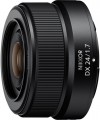Aperture value
Lens aperture is a characteristic that determines how much the lens attenuates the light flux passing through it. It depends on two main characteristics — the diameter of the active aperture of the lens and the focal length — and in the classical form is written as the ratio of the first to the second, while the diameter of the active aperture is taken as a unit: for example,
1 / 2.8. Often, when recording the characteristics of a lens, the unit is generally omitted, such a record looks, for example, like this:
f / 1.8 or
f/2.0. At the same time, the larger the number in the denominator, the smaller the aperture value:
f / 4.0 lenses will produce a darker image than
models with f / 1.4 aperture.
Zoom lenses usually have different aperture values for different focal lengths. In this case, the characteristics indicate two aperture values, for the minimum and maximum focal lengths, respectively, for example: f / 4.5-5.6
The larger the aperture of the lens, the shorter shutter speeds it allows you to use when shooting. This is especially important when shooting fast-moving subjects, shooting in low light, etc. And if necessary, the light stream transmitted by the lens can be weakened using a diaphragm (see below).
Another point that directly depends on this indicator is the depth o
...f field (the depth of space that is in focus when shooting). The higher the aperture, the smaller the depth of field, and vice versa. Therefore, shooting with artistic background blur (bokeh) requires high-aperture optics, and for a large depth of field, you have to cover the aperture.Min. diaphragm
Aperture is a design of several blades-curtains, which allows, if necessary, to reduce the diameter of the active aperture of the lens, actually reducing its aperture (for more details, see "Aperture"). In addition to reducing the light output (which can be relevant, for example, in bright sunlight), closing the aperture has another effect — it increases the depth of field. In other words, “in focus” is a larger volume of space than with an open aperture.
The values on the aperture scale are usually selected from a standard range. The numbers in it actually indicate what aperture the lens will have when the aperture is closed to a given value: for example, an aperture value of 5.6 will correspond to f / 5.6 aperture. The larger the number indicating the minimum aperture value, the more options the photographer has and, accordingly, the possibilities for setting the shooting mode (ceteris paribus).
Minimum focus distance
Minimum focus distance (m) - the smallest distance from which you can focus on an object and take a photo. Usually it ranges from 20 cm for wide-angle lenses to several metres for telephoto. In the macro mode of the camera or with the help of macro lenses, this distance can be less than 1 centimeter.
Maximum zoom
The degree of magnification of the object being shot when using a
lens for macro shooting (that is, shooting small objects at the maximum possible approximation, when the distance to the subject is measured in millimetres). The degree of magnification in this case means the ratio of the size of the image of the object obtained on the matrix of the camera to the actual size of the object being shot. For example, with an object size of 15 mm and a magnification factor of 0.3, the image of this object on the matrix will have a size of 15x0.3=4.5 mm. With the same matrix size, the larger the magnification factor, the larger the image size of the object on the matrix, the more pixels fall on this object, respectively, the clearer the resulting image, the more details it can convey and the better the lens is suitable for macro photography. It is believed that in order to obtain macro shots of relatively acceptable quality, the magnification factor should be at least 0.25 – 0.3.
Filter diameter
Thread diameter for installation on the filter lens. Light filters are devices for changing the parameters of the light flux entering the lens. They can be used for highlighting individual colours, coloring the entire image in one colour, darkening the image, correcting colour temperature and light balance, shooting in the infrared range, etc. Also, a light filter can play the role of protection against pollution. For successful installation on the lens, the diameter of the filter must match the diameter of the filter specified for this model of optics.

